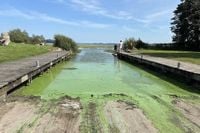On Monday evening, September 8, 2025, a palpable sense of urgency filled the Kinturk Cultural Centre in County Tyrone, where about 100 people gathered to confront a crisis that’s been quietly choking Northern Ireland’s largest freshwater lake. Fishermen, elected officials, campaigners, and concerned locals came together to discuss the worsening pollution crisis at Lough Neagh—a crisis that, for the third consecutive summer, has left the water blanketed in noxious blue-green algae.
“How have we got to this again?” fisherman Gary McErlain asked the crowd, his frustration echoing throughout the hall. “This is something we can’t fix ourselves. We are asking politicians: ‘What are you doing to help us?’ We need politicians to be working on our behalf.” According to the BBC, this public meeting was just the latest in a series of events this summer focused on the ongoing issues at Lough Neagh, and the stakes have never felt higher.
Blue-green algae—technically known as cyanobacteria—has been detected more than 100 times across Northern Ireland in 2025, with the lion’s share of sightings in Lough Neagh, the Lower Bann, and Lough Erne, as reported by the Belfast Telegraph. The blooms, which thrive in nutrient-rich, sunlit waters, have become a recurring nightmare, discoloring the water and forming thick mats that threaten both wildlife and human health. Skin irritation and sickness are risks for those who come into contact with the algae, but the greatest danger is to pets, livestock, and the fragile ecosystems that depend on the lough.
For the fishermen who rely on Lough Neagh, the crisis has already hit home. Earlier this summer, the Lough Neagh Fishermen’s Co-Op extended a ban on commercial eel fishing—a move that underscores just how dire the situation has become for local livelihoods. As one fisherman put it at a recent demonstration, the UK’s largest freshwater lake was “already dead.”
Yet, as the crisis deepens, so too does the debate over its causes and solutions. The science is clear: pollution in Lough Neagh comes largely from agriculture, with significant contributions from wastewater processing, septic tank seepage, and industrial runoff. Nitrogen and phosphorus from farm fertilizers, in particular, have been singled out as key drivers of the algal blooms. The spread of invasive zebra mussels and warmer water temperatures—exacerbated by climate change—have only made matters worse.
John McLenaghan of the Ulster Farmers Union addressed the meeting, acknowledging the gravity of the issue while urging a balanced approach. “As farmers, we have never walked away from this issue. There has been misinformation. But we as farmers, we recognize the importance of the lough and the importance of water quality. It’s not about a blame game. It’s important to keep balance here,” he said, according to the BBC.
But for many in attendance, patience with political process is wearing thin. Ms. Shrewsbury, a grandmother from the area, took her protest directly to Stormont, bringing with her a bottle of “Lough Neagh smoothie”—water drawn from the lough itself. “I’m here today as a voter, a member of the public, someone who drinks water in Northern Ireland and as a grandmother of two small children who also drink water from Lough Neagh, and I’m here because I am so, so concerned now about what is happening to Lough Neagh,” she told the Belfast Telegraph. “I don’t understand what are the MLAs doing.”
The Department of Agriculture, Environment and Rural Affairs (DAERA) claims to be working on solutions. Minister Andrew Muir has been “very clear in interviews in recent days about the actions that need to be taken to address the blue-green algae problems in Lough Neagh and other waterways,” a DAERA spokesperson said. “The minister has also been clear that political support will be required in the coming months for those actions to proceed.”
Potential solutions are being piloted as part of the executive’s action plan, including two small business research initiatives whose second phases are set to be announced soon. Among the more novel ideas is a “bubble barrier” designed to trap algae before it can spread, as well as the use of drone and satellite technology to predict and detect blooms before they become unmanageable. The Sustainable Utilisation of Livestock Slurry (SULS) program and the Soil Nutrient Health Scheme, now in its final year, aim to tackle the root cause of nutrient pollution, while the Nutrients Action Programme (NAP) seeks to address water pollution from agricultural sources more broadly. Still, as the BBC reports, it will be several years before any of these measures have a direct impact on the lough.
Veteran activist Bernadette McAliskey, speaking at the Kinturk meeting, emphasized the need for collective responsibility. “No savior from on high will save the lough, we must do it ourselves,” she said, as reported by The Irish News. “If we want a vision of Lough Neagh which suits us all, that vision has to be a vision that respects the fundamental rights of nature itself. When we talk about owning the lough, we shouldn’t see it as property or an asset. We should be collectively responsible and accountable for ensuring the lough is restored to health as a priority. If we thought that way we would make sacrifices like we do for our own children.”
McAliskey also highlighted a deeper philosophical challenge: “It’s very hard to decide how to get somewhere if you weren’t very sure where you wanted to go. What we’re missing going forward with Lough Neagh is that we have a lot to say about what’s wrong. Everybody has a bit of the answer to put it right, but that answer is what somebody else would have to do. When pointing the finger of blame, we have to think what we’re doing to put it right.”
But the roots of the crisis go deeper than algae and agriculture. In an opinion piece published on September 9, 2025, Louise Taylor described Northern Ireland as an environmental “sacrifice zone”—a place disproportionately burdened by environmental degradation and political neglect. Taylor points out that Lough Neagh, which supplies drinking water to 40% of Northern Ireland’s population and covers an area larger than Malta, was never accounted for in the peace process that followed the Good Friday Agreement. “This oversight is difficult to account for but has cost the population dearly in terms of environmental and public health,” Taylor writes in E-International Relations.
Northern Ireland is the only part of the United Kingdom without an independent environmental agency or a dedicated government department for the environment or climate. Instead, DAERA combines responsibility for both agriculture and the environment—a situation many campaigners see as a conflict of interest. Funding, too, is a perennial issue: the government has allocated only £7.5 million to address the Lough Neagh crisis, while the cost to update wastewater infrastructure alone is estimated at £2–3 billion.
Dedicated research facilities that once monitored nutrient levels in Lough Neagh were shuttered after the Good Friday Agreement, leaving a critical gap in data and oversight. Meanwhile, recent decisions to grant new mining prospecting licenses in areas of outstanding natural beauty have fueled accusations that international economic interests are being placed above the health and wishes of local communities.
As Northern Ireland’s environmental woes mount, there is at least one glimmer of hope: in 2024, Lough Neagh became the first environmental project ever to be included in the programme for government. But for many, this is only a first step. As campaigners, scientists, and citizens continue to push for accountability and action, the future of Lough Neagh—and the communities that depend on it—hangs in the balance. The lough itself, as McAliskey reminded the crowd, will outlast us all. The question is whether we will act in time to preserve the life it sustains.


